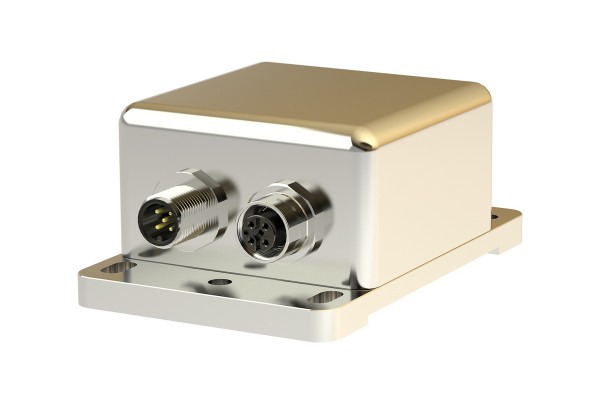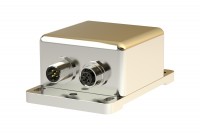Something is moving - but if possible not in such a way that there are disturbances in an operational sequence and certainly not accidents. TWK is contributing by means of a sensor fusion with a gyroscope and is offering inclinometers with gyroscope correction. "Gyros" comes from Greek and means rotation - so it has to do with rotary movements. It is the clever combination of measurement signals with a corrected output signal which indicates the measured angle precisely - even under adverse operating conditions.
What is the task definition?
Well, it involves measuring inclinations. An inexpensive and nevertheless good method is to use so-called MEMS sensors for this purpose. These electronic chips are small and consist of electronic and micromechanical structures, i.e. in addition to the usual microelectronic circuits, mechanically movable structures are also present in the chips. These structures deflect when the earth's g force acts on them. At the same time, the capacitances formed by these structures (capacitors) change. These are registered by means of measuring technology and an inclination angle is calculated and output.
If this MEMS cell is now exposed to other accelerations besides gravitational acceleration, however - be it due to vibrations or accelerations in a vehicle - these MEMS structures are also moved and a falsified inclination value is output. The connected control system may react incorrectly and an accident may occur - with a mobile machine, for instance: mobile cranes, concrete pumps, fork-lift trucks, etc.
This is where the gyroscope comes into play. It is a rotation rate sensor, also in MEMS technology. However, the micromechanical structures are designed in such a way that angular velocities (°/s) are measured and output as an output signal. It therefore measures changes in an inclination angle rather than the inclination angle itself when the MEMS gyroscope rotates around its own axis or an extended axis. The advantage is that the above mentioned linear accelerations which interfere with the acceleration MEMS sensor do not influence the gyroscope MEMS sensor as they do not represent rotation
How can these two sensors now be combined to form an interference-insensitive inclination measuring system?
With sensor data fusion and Kalman filter! The solution is to combine both measurement signals and optimise them using a specific filter - the Kalman filter. This filter technology makes it possible to calculate, correct and predict the measured value to be output, i.e. to determine it in advance for a short time. This is necessary because the acceleration sensor cannot provide an exact measured inclination value when dynamic interfering accelerations occur. Instead, the next output values are first estimated in real time (<1 ms cycle time) using a recursive algorithm based on the previous measured values and are then continuously optimised using new, real measured values. In order for the rotation rate sensor signal to be added, it first has to be integrated over the time. Finally, a range of parameters serves to optimise the system as well as possible, to smooth the measured values and, if necessary, to adapt them to application-specific conditions. All possible application-oriented simulations and measurements at TWK show that the sensor fusion system works precisely and reliably and enables refresh rates of significantly less than 1 ms - not least thanks to ingenious and 'space-saving' programming in the controller.
The figure (Kalman filter) shows an inclination change measurement with interference components (red). While simple averaging of the pure acceleration data over 1000 values (green) can smooth moderate vibrations, it causes a noticeable time lag (~1 s). The fusion of both sensors via the Kalman filter (blue) leads to almost ideal behaviour.
This sensor system not only ensures safe, hazard-preventing operation for mobile machines, but also during the operation of engines,
hydraulic pumps or other actions that generate strong vibrations. It measures more accurately and faster than previous sensors and is extensively insensitive to interfering accelerations and also to transverse deflection. These sensors are highly suitable for applications with dynamic requirements in which precise inclination angles nevertheless have to be registered continuously and transmitted to a control system.
Where can they be used?
One good example of the use of fusion sensors is mobile concrete pumps. These vehicles drive to a construction site, are aligned - i.e. the undercarriage is adjusted horizontally - and the boom with the trunk is extended. The undercarriage and boom are equipped with inclinometers - everything is fine so far. When the concrete pump now pumps the concrete, however, it results in short but strong shocks. The accelerations that occur disturb the inclination measurement. The gyroscope's signal is 'zero' despite the linear interfering acceleration. The calculation algorithm then recognises that there is no change in inclination and maintains the previous inclination value, which is now subject to strong fluctuations on the MEMS side. If the inclination changes exactly at the time of the disturbance, the gyroscope outputs a change in °/s whose integral is not 'zero'. Both values are analysed by the Kalman filter and are in turn used to generate a realistic inclination value.
The combined sensors have a working temperature range of -40°C to +85°C and measure inclination angles up to ±100° with a resolution of 0.01° and an accuracy in the range of ±0.1°. The reaction time is 0.1 s. One-axis or two-axis measurement is possible. With a system of protection of IP67, the stable aluminium housing can withstand even adverse environmental conditions with ease. Systems of protection up to IP69K are possible.




